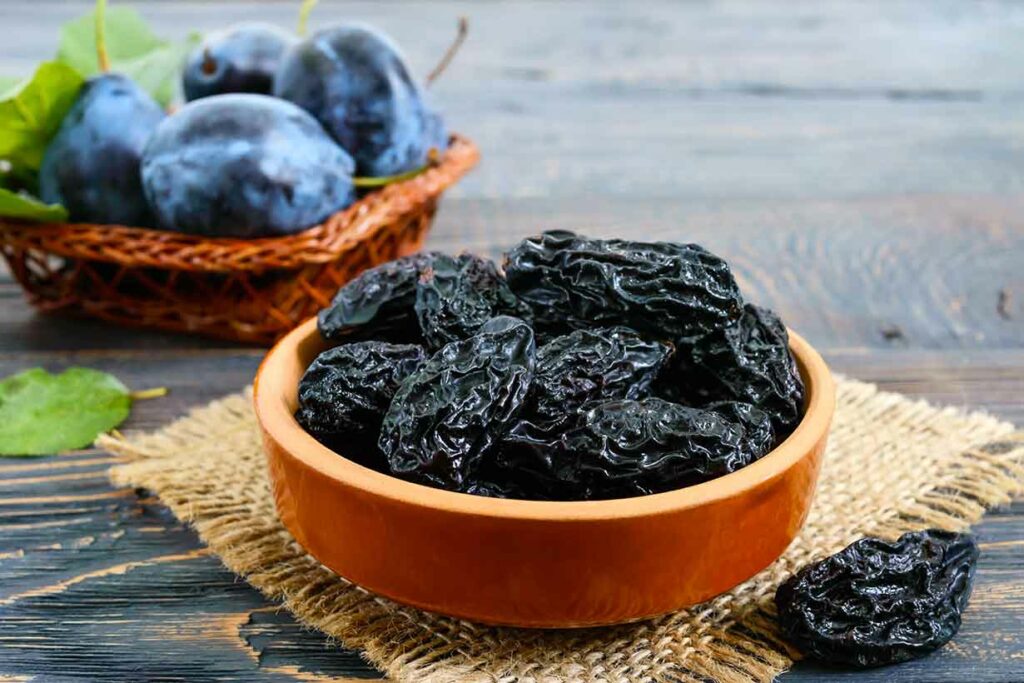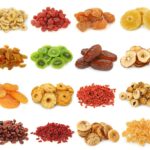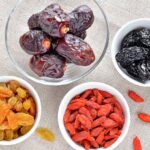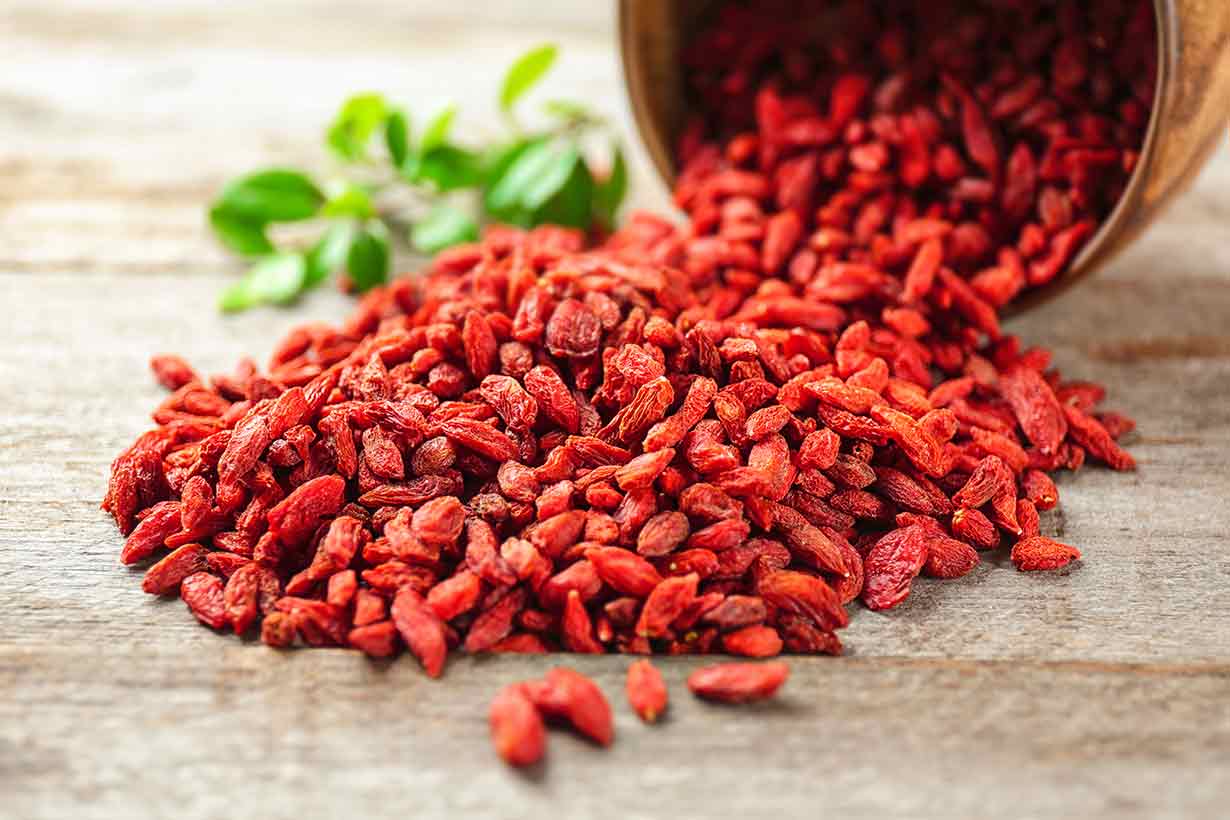Prunes are a popular dried fruit variety made by drying fresh plums.
For this reason, prunes are sometimes called ‘dried plums.’
This article takes an in-depth look at the nutritional values of prunes and how they compare to fresh plums.
What potential benefits and downsides do they have?

Table of contents
What Are Prunes?
Before looking into the nutritional properties of prunes, let’s first look at what they are.
Although several varieties of plum can be used to make prunes, it is usually the European plum (known scientifically as ‘Prunus domestica’) (1).
The most significant difference between prunes and plums is the water content. As part of the drying process, prunes lose most of their water.
This water loss gives prunes different taste and texture characteristics compared to plums.
Interestingly, prunes are big business. According to the International Prune Association (IPA), global production hit 265,000 tonnes in 2021 (2).
Most of the global prune production comes from Chile, which had a 29.9% share of international prune exportation in 2021. The United States closely followed Chile, with a 27.73% share of global exportation (3).
Unlike plums, prunes are not juicy and have a somewhat moist and chewy texture. In addition, prunes are a fruit with a dark blue-ish to a purple-black range of colors.
Among their uses, prunes can be consumed as a snack or used in various savory and sweet recipes. Prunes are flavorful and have a unique caramel-like sweet taste.
Alongside dried apricots, dates, raisins, and sultanas, prunes are one of the most common forms of dried fruit.
How Are Prunes Made?
The prune production process is relatively simple.
The website ‘California Prunes’ has an informative description of how plums become prunes. In short, the process includes the following steps:
- After ripening on trees, plums are picked, primarily by machines.
- Next, after washing, the plums are dehydrated in drying machines.
- After drying the fruit, the prunes move to cool storage facilities ready for processing and packing.
- Before being packed, the prunes are rehydrated and sterilized. Finally, after packing, they are prepared for shipping.
Nutritional Values
Based on data direct from the USDA’s FoodData Central database, the following section shows the nutritional values of prunes per 30-gram serving. Thirty grams is approximately three prunes (4).
Daily values have been calculated using the USDA data alongside the FDA’s published daily values (4, 5).
Nutrition Facts
| Name | Amount | % Daily Value (DV) |
|---|---|---|
| Calories | 72 kcal | |
| Carbohydrates | 19.16 g | 7.0% |
| Fiber | 2.13 g | 7.6% |
| Sugars | 11.44 g | |
| Fat | 0.11 g | 0.1% |
| Saturated | 0.03 g | 0.2% |
| Monounsaturated | 0.02 g | |
| Polyunsaturated | 0.02 g | |
| Omega-3 | <0.01 g | |
| Omega-6 | <0.01 g | |
| Protein | 0.65 g | 1.3% |
As shown in the table, prunes are primarily a source of carbohydrates and are relatively high in fiber.
Vitamins
- Vitamin K: 14.9% of the daily value (DV)
- Riboflavin (B2): 4.6% DV
- Vitamin B6: 3.5% DV
- Niacin (B3): 3.5% DV
- Pantothenic acid (B5): 2.6% DV
- Thiamin (B1): 1.7% DV
- Vitamin A: 1.3% DV
- Vitamin E: 0.9% DV
- Choline: 0.6% DV
- Vitamin C: 0.2% DV
- Folate: 0.1% DV
Minerals
- Potassium: 4.7% DV
- Manganese: 3.9% DV
- Magnesium: 2.9% DV
- Phosphorus: 1.7% DV
- Iron: 1.6% DV
- Zinc: 1.2% DV
- Calcium: 1.0% DV
- Copper: 0.9% DV
- Selenium: 0.2% DV
- Sodium: <0.1% DV
How Do Prunes Compare To Plums?
The following table shows how one prune (dried plum) compares to a fresh plum nutritionally per fruit and 100 grams (4, 6).
| Name | Per Prune | Per Fresh Plum | Per 100g Prunes | Per 100g Plums |
|---|---|---|---|---|
| Weight | 9.5g | 66g | 100g | 100g |
| Water content | 2.94g | 57.6g | 30.9g | 87.2g |
| Calories | 23 kcal | 30 kcal | 240 kcal | 46 kcal |
| Carbohydrates | 6.07g | 7.52g | 63.9g | 11.4g |
| Fiber | 0.67g | 0.92g | 7.1g | 1.4g |
| Sugars | 3.62g | 6.55g | 38.1g | 9.92g |
| Fat | 0.04g | 0.19g | 0.38g | 0.28g |
| Saturated | <0.01g | 0.01g | 0.09g | 0.02g |
| Monounsaturated | <0.01g | 0.09g | 0.05g | 0.13g |
| Polyunsaturated | <0.01g | 0.03g | 0.06g | 0.04g |
| Protein | 0.21g | 0.46g | 2.18g | 0.7g |
The above table shows that prunes and plums provide a similar nutritional profile per fruit.
However, prunes have much higher calorie and nutrient levels per 100 grams. This is because prunes have a much lower water content, so there are more prune fruits than plum fruits per 100 grams.
Potential Benefits
Aside from providing essential nutrients, prunes may have some additional benefits.
Here are some potential benefits of prunes, according to published research.
Prunes May Relieve Symptoms of Constipation
Several studies indicate that prunes may be beneficial for relieving constipation symptoms.
A systematic review published in 2021 examined the efficacy and safety of over-the-counter therapies for chronic constipation (7).
The review looked at 41 studies, including comparative trials between different products. Notably, one randomized controlled trial (RCT) included in the review demonstrated that, when matched for fiber, prunes were more effective than psyllium supplements for treating mild to moderate constipation (8).
A recent RCT published in 2021 also examined the effects of psyllium, prunes, and kiwifruit on chronic constipation (9). The trial involved seventy-nine patients with fewer than three complete bowel movements per week.
The trial’s results demonstrated that 100 grams of prunes per day significantly increased bowel movements and stool consistency after four weeks.
May Have Benefits For Bone Health
Interestingly, research has indicated that prunes may benefit bone health.
A 2021 randomized controlled trial published in the Journal of Medicinal Food examined the effect of prune intake on bone health (10).
In this trial, sixty-six men were assigned to either a control group (no prunes) or an intervention group (100 grams of prunes per day). Blood samples were taken at 3, 6, and 12 months and showed signs of bone-protective changes in markers of bone health.
A more recent randomized controlled trial, published in January 2022, found that regular intake of prunes (at 50-100g per day) appears to improve (by decreasing) bone turnover (11).
Bone turnover refers to the rate at which new bone tissue replaces older bone. Elevated bone turnover rates are associated with loss of bone mass density (12, 13, 14).
Furthermore, a randomized controlled trial published in July 2022 looked at the effect of prunes on hip bone mineral density. This study analyzed the impact of 50 grams, 100 grams, or zero grams of prunes per day, for 12 months, in postmenopausal women (15).
The study’s results demonstrated that the control group (no prune intake) lost 1.1% of hip bone mass density over 12 months. However, women in the group consuming 50g of prunes per day preserved bone mass density.
These results are interesting and appear to suggest that prunes may benefit bone health.
However, more extensive and rigorous studies are necessary to confirm this.
Prunes Are a Rich Source of Polyphenols
Polyphenols are bioactive chemicals found in plant foods, some of which may exert health-protective effects on the human body (16).
Notably, prunes are one of the most polyphenol-rich common foods in the human diet.
On this note, research demonstrates that prunes contain around 184 mg of polyphenols per 100 grams. Furthermore, a breakdown of the polyphenol found in prunes identifies that hydroxycinnamic acids are the most prevalent (17).
Research from the 1990s indicated that phenol-rich prune extracts could inhibit LDL cholesterol oxidation in vitro (18). In vitro means “outside the body” (for example, studies that use test tubes).
Higher rates of oxidized LDL cholesterol are a risk factor for atherosclerosis (the build-up of plaque in the arteries), which can lead to cardiovascular disease and cardiovascular events (19).
However, there is little research on prune polyphenols and their human health effects. In other words, we cannot assume results seen from in vitro studies would be the same in human clinical trials.
Prunes Have a Low Glycemic Index
Despite tasting sweet, prunes have a relatively low glycemic index.
The glycemic index ranges from 1 to 100 and refers to the extent to which a specific food can raise blood glucose levels.
Pure glucose has a glycemic index of 100, whereas fruits such as ripe bananas score 51 (20).
In the case of prunes, they have a glycemic index of 29, which is classed as ‘low’ (20, 21).
Potential Downsides
Although prunes are generally a nutritious and healthy choice, there are also some potential downsides.
Laxative Effects
Prunes might be capable of having a laxative-like effect when consumed in high doses.
A 2016 systematic review on the health effects of plums (and prunes) notes that this laxative effect can be attributed to the sorbitol content of the fruit combined with its high fiber and chlorogenic acid content (22).
However, any adverse effects of this nature are unlikely if sticking to recommended serving sizes. A typical serving of prunes is usually around three to five prunes.
Can Be Easy To Over-Consume
Another point to consider is that it can be relatively easy to over-consume prunes.
Prunes are sweet and chewy with an enjoyable texture and have a much lower volume than fresh plums.
As shown in the earlier comparison between the two, a plum contains lots of water and weighs more than six times more than a prune (66g compared to 9.5g) (4, 6).
For this reason, prunes are not as filling as fresh plums, and it can be much easier to over-eat them.
However, this is not unique to prunes and tends to be true of dried fruit in general.
For more information on the nuances of dried versus fresh fruit, see this article examining whether dried fruit is a healthy choice.
How To Use Prunes
There are many different ways to use prunes, and here are some example ideas of how to eat them:
- Alongside other dried fruits, nuts, and seeds in a trail mix
- Add diced prunes to porridge
- Combine them with meat in a dish such as braised pork with prunes
- Add to curries and stews
- Use in dessert recipes
Are Prunes Good For You?
Prunes offer a good range of nutrients and, potentially, benefits for bone and gastrointestinal health.
As with all dried fruit, prunes can be a great way to get some extra fiber, vitamins, and minerals.
On the other hand, it can be easy to over-consume prunes, which are high in sugar (and thus calories).
In summary, if sticking to reasonable serving sizes, prunes can be a good addition to the diet.






